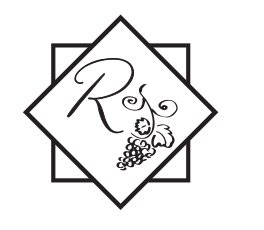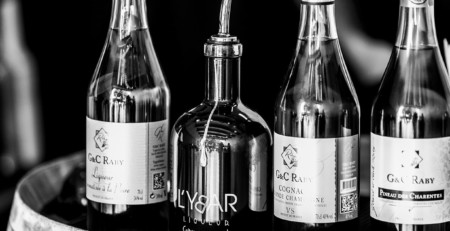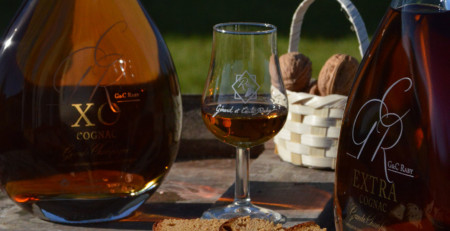Pineau des Charentes: a unique know-how
Pineau des Charentes is a liqueur wine, obtained by blending grape must and cognac.
Before discussing the characteristics of this very special drink, let’s look at its creation. The Charentes region is well known for its vine growing. This cultivation began in Roman times. At that time, vines were only planted in one region, the Saintonge. Very quickly this culture spread and covered Cognac. A new economy appeared in the Charente. It is for this reason that the histories of Pineau des Charentes and Cognac are closely linked.
The “birth” of Pineau des Charentes
This unexpected mixture of a distilled and a fermented product appeared in 1589, in a commune in the South-West of France, called Burie. According to a Charente legend, the creation of this Pineau was a coincidence. A winegrower inadvertently poured some grape must into a barrel filled with “Cognac eau de vie”. A few years later, this man opened the same barrel and discovered a new drink, the famous Pineau des Charentes.In 1945, the liqueur wine became an AOC (controlled designation of origin). This date marked the beginning of the international export of Pineau des Charentes. This appellation area extends over the cognac vineyards in Charente and Charente-Maritime, but also over a few communes in Dordogne and Deux-Sèvres.
A particular geographical situation
Pineau des Charentes is cradled between land and sea. The climate in Charente is ideal with mild winters and sunny summers. The relief is not very marked, with a succession of plains. The grapes draw all their strength from the limestone soil. Pineau des Charentes has different aromatic characteristics depending on the grape variety used. Indeed, you will not find the same flavours in a white Pineau as in a red Pineau. White Pineau is mainly made from ugni blanc, colombard, sauvignon and sémillion grapes, whereas red Pineau des Charentes is made from merlot noir, malebec, cabernet sauvignon and franc.
A unique know-how
Pineau des Charentes is rooted in very specific winemaking traditions. Indeed, the grape must and the “Cognac eau de vie” have to come from the same vineyard. We can distinguish five essential stages in this elaboration. Everything starts with the harvest. During the summer, the grapes have soaked up the sun and have drawn all their strength from the Charente soil. At the end of September, it is time to harvest them. Then comes the pressing. The grape must is pressed. It is here that a difference will appear between the conception of the white Pineau des Charentes and the red Pineau des Charentes. For the white, the white grapes are pressed as soon as the harvest is finished, whereas for the red, the grapes go through a period of maceration lasting several hours. It is this period that gives the red Pineau des Charentes its beautiful colour. Then comes the mutage. It is the centre of the elaboration of the liqueur wine. The mutage consists in mutating the grape must with Cognac eau de vie (minimum one year old), the famous mistake made by the Charente winegrower in the 16th century. This phase suspends the fermentation process of the grape must. Then comes the longest phase: ageing. “The best things need patience”. The ageing is done in oak barrels, just like ageing of Cognac eau de vie. A white Pineau will age for a minimum of 18 months, of which 12 months in barrels, a red Pineau will age for 12 months, of which 8 months in barrels, and a rosé Pineau will age for a minimum of 8 months, of which 6 months in barrels. During this phase, the Pineau des Charentes will acquire the last missing aromatic touches. But how do you obtain an old or very old Pineau des Charentes? To obtain these delicious liqueur wines, the ageing process is extended by 5 or 10 years in oak barrels. The last stage in the production of Pineau is bottling. This process must follow very specific rules. Bottling must take place in the region where Pineau des Charentes is produced.
How to drink this liqueur wine?
Pineau des Charentes is a drink for all occasions. It is ideally served in a tulip glass. But why a tulip glass? The shape of this glass perfects the aromas and concentrates them towards the consumer’s nose.
If you want a simple recipe to enjoy this liqueur wine as an aperitif, nothing could be easier. Pineau des Charentes only needs freshness to release all its aromas. It is best served between 8° and 10°. Pour it into a glass and add an ice cube and that’s it!
If you prefer to drink it as a digestif, you can opt for an old Pineau des Charentes or a very old one. At this point, serve it at temperature, just chilled. All you have to do is enjoy it.
Pineau des Charentes is also very good with tonic or fruit juice. You can find a cocktail menu on our website cognac-raby.com. You will then discover our cocktail based on Raby white pineau: the Raby’Jito.
And if you are a gourmet, Pineau des Charentes goes perfectly with meat, fish or seafood. As for sweet dishes, it is delicious with our famous Galette Charentaise.
How is Pineau des Charentes kept?
The bottle must always be upright. If your bottle is already opened, don’t panic, the Pineau can be kept in the refrigerator if it is corked.
Come and meet us
Come and see us in our shop, 3 bis La Brée, 16130 Segonzac, France or on our website cognac-raby.com to discover our Pineau des Charentes. We propose a white Pineau (20cl or 75cl) which will go perfectly with a foie gras or a chocolate dessert. We also recommend our red Pineau (20cl or 75cl) which will go well with melon, fruit salad or sorbet. You can also take part in a free visit of our property followed by a tasting of our products, during which you will discover our Pineau and other products. We also offer an online sales service where you will find our red and white Pineau, our VS, VSOP, XO and EXTRA cognacs, our 6 liqueurs, as well as our red still grape juice and our white carbonated juice, and our white, red and rosé wines.





